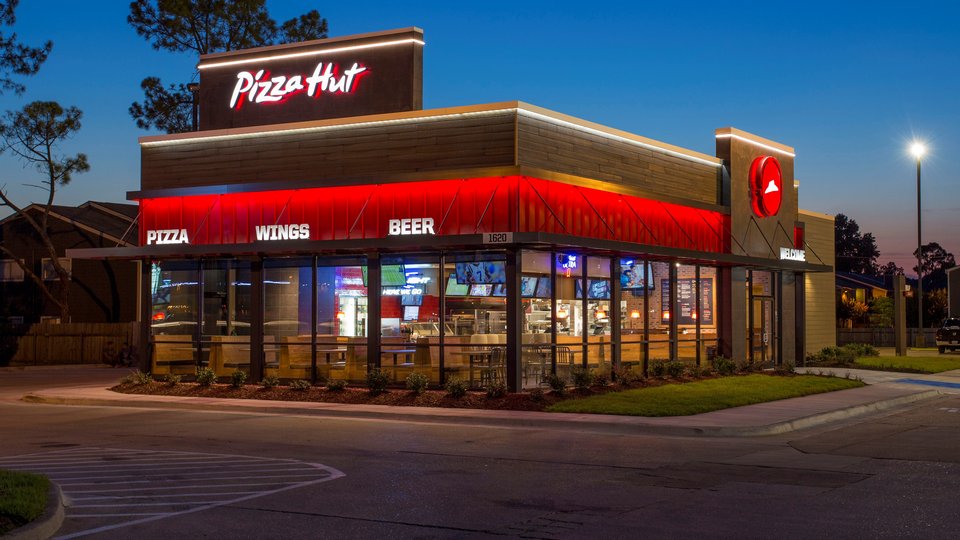Food & Beverage
Pizza Hut stock gaining despite pandemic
Most pizza brands don't appear to be suffering lower sales from the surge in COVID-19 cases nationally, though some commodities providers are experiencing signs of possible upcoming reduced demand.

November 16, 2020 by S.A. Whitehead — Food Editor, Net World Media Group
Most pizza stock values are showing little signs yet of possible repercussions resulting from the recent rise in U.S. COVID-19 cases — despite dine-in restrictions returning in some states in hopes of getting control over the virus.
On Wall Street last week among the prevailing publicly traded pizza brands, Pizza Hut parent, Yum Brands, turned in the best performance over the five days. The Louisville, Kentucky-based company benefited from a $3.49 lift over the week in its value, which closed Friday at $102.87. The smaller two-brand pizza company, Rave Restaurant Group — parent of Pie Five and Pizza Inn — also got a tap up over the week's trading, closing Friday at 70 cents, 2 cents more than the previous week's close.
For power-players, like Ann Arbor, Michigan-based, Domino's, and Louisville, Kentucky-based, Papa John's, however, the week was a little less friendly. Domino's lost $10.25 in value over the week to close Friday at $389.60. At Papa John's, the loss for the week was $2.44, which put the company at a value of $80.98 at markets' close on Friday afternoon.
Cheese
In cheese trading last week, prices were down on average, with barrels falling 47 cents in price to an average of $2, while 40-pound blocks averaged $2.15, down 45 cents. For the week, barrels closed at $1.61, while 40-pound blocks at $1.92.
The U.S. Department of Agriculture reported that cheese market contacts have said they have expected "bears" during the price runup for cheese of recent weeks, as those bears have indeed appeared in force. Cheese plant managers stayed slightly ahead of the trend though with many recently reporting lighter production schedules of late.
Nationally, the U.S.D.A. said restaurateurs are working through restrictions due to COVID-19 surges as well as cooler weather that restricts the outdoor seating options many had come to depend on. As a result the U.S.D.A. said that orders into private food service sectors are, and will remain, challenging on both the production and buyer sides.
Wheat
Chicago Board of Trade March soft red winter futures dropped 7 cents last week, ending the week's trading at $6.02 per bushel. On the Minnesota Grain Exchange, hard red winter wheat futures fell 2 cents to come in at $5.60 per bushel, the U.S.D.A. reported.
On the Kansas City Board of Trade, March hard red winter wheat futures fell 2 cents, ending the week at 5.60 per bushel. Meanwhile, last week's commercial sales of 300,000 metric tons to be delivered this year and next fell nearly 50% from 597,000 metric tons.
Auto fuel
Over the five weekdays last week, the American Automobile Association reported that the national average for a gallon of regular gasoline grew one cent to $2.12, which is still 6 cents less than a month ago and 49 cents under what the price was last year at this time.
The U.S. Energy Information Administration said demand for gas increased from 8.34 million barrels a day (b/d) to 8.76 million b/d. That increase, along with lower total domestic stocks, pushed the national average cost of a gallon of gas up slightly over the week.
The Energy Information Administration, however, said that weekly demand remains 560,000 barrels a day lower than last year's rate at this time. Low demand will likely contribute to pump prices remaining low this autumn, AAA said.
States with the largest weekly increase in average gas prices were topped by South Caroline, which was up 6 cents on average. That was followed by an average 5-cent increase in Wisconsin and New Mexico (up 5 cents each) and Washington, D.C. (+4 cents).
This morning the national average for a gallon of regular unleaded stood at $2.13, up 2 cents from a week earlier. Mid-grade ($2.48) and premium ($2.74) were each up a cent from the previous week.
At $2.39, the average price for diesel was up 3 cents a gallon, while at $1.94, E85 was flat week to week.
Natural gas
Natural gas spot prices rose at most locations for the seven days that ended on Nov. 11. The Henry Hub spot price rose from $2.60 per million British thermal units (MMBtu) to $2.77/MMBtu that same period.
At the New York Mercantile Exchange, the price of the December 2020 contract decreased 1 cent, from to $3.03/MMBtu. The price of the 12-month strip, averaging December 2020 through November 2021 futures contracts, declined 1 cent/MMBtu to $2.99/MMBtu.
The natural gas plant liquids composite price at Mont Belvieu, Texas, rose by 19 cents/MMBtu, averaging $5.38/MMBtu for the period. The price of ethane fell by 2%. The prices of propane, isobutane, natural gasoline, and butane rose by 4%, 5%, 6%, and 12%, respectively.
About S.A. Whitehead
Pizza Marketplace and QSRweb editor Shelly Whitehead is a former newspaper and TV reporter with an affinity for telling stories about the people and innovative thinking behind great brands.










